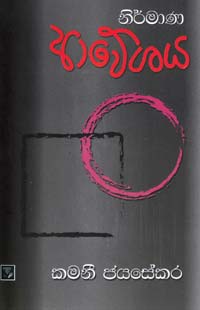|
Focus on Books
Creative inspiration and creative process
Title:
Nirmana Aveshaya
Genre:
Essays of criticism
Author:
Professor
Kamani Jayasekara
Publisher:
Tharanga Publishers
Price:
Rs. 360
Page count: 228
Cover picture:
Patrick Rathnayaka
In world literary circles quite a number of books are written on
creative communication. Some of these books cover aspects such as
creative thinking, inspiration, sources and process.
The general reader and the aesthete may like to know how his favorite
writer wrote a particular creative work. Similarly a music fan may wish
to know how a particular symphony came to be or a particular song came
to be written or came to be sung by a musician.
In this manner the entire field of creative communication covers a
wide gamut of aspects and nuances. These may be presented in notes,
learned papers interviews and even in the form of a dialogues. But the
facts so covered may be genuinely felt sensitive expression.
 The interviews with 22 dons from the University of Kelaniya cover the
creative inspirations and processes in the field of literary creations
such as narrative poetry, drama, criticism, translations and religious
concepts. The interviews with 22 dons from the University of Kelaniya cover the
creative inspirations and processes in the field of literary creations
such as narrative poetry, drama, criticism, translations and religious
concepts.
The university over the years has produced not only academics
narrowly bent on scholarly ventures, but also novelists, poets,
dramatists, critics and innovative communicators on religion, philosophy
and folklore.
Professor Kamani Jayasekara in this compilation makes an attempt to
be selective on the creative communicators. She, being a researcher in
the field of Greek literature, mentions that at the outset she wanted to
inquire into the concept of inspiration, which in Sinhala termed as
Aveshaya.
Though I am not too sure whether this is appropriate or not,
nevertheless expressed and covers a wide field of basic functions
triggering off from such questions as how does one write or why should
one write or where does one write. Similarly yet another series of
questions could be raised.
They may cover socio-cultural aspects as manners, morals and beliefs
reaching to wider subject areas as love sex and censorship.
As a reader I found some of the responses quite stimulating. The
responses may differ from person to person.
A university don who writes poems says that he does not discuss his
creative works with others, not because of any inhibition but lest being
critical on the part of the others. Then there are short story writers
and novelists who admire places such as clubs and recreation centres to
find isolation in busy circles for creative inspiration.
There are also moments when some others fail to express whether to
write, and they sometimes believe that creative inspiration is a sudden
mental awakening. Then we encounter some university dons who dislike or
abhor critical methods applied in the field of literature in the
contemporary scene.
The compiler Jayasekara has been engaged in the field over a period
of 20 years or so. From the commencing moment of the concept for the
book reached her, she had been visualizing the modus operandi for her
research.
As time passed she had managed to line up her methodology for herself
culminating in a series of seminars and interviews, discourses and
discussions with her selective circles of companions drawn from the
academic staff.
The method she designed had been well documented and restored, giving
a creative vent to the contents. Instead of a brief biography of each
person in the compilation, a list of their contributions is recorded.
This indeed is a good starting point.
As the pages of this compilation moves in an interesting resourceful
tone, the basic definition of communication if indirectly addressed as
who says, what in which channel for what effect? Some believe that
creative function is an entity which is partly gifted from birth and
living surroundings, gradually elevated via training at both school and
university education.
Some others believe that the very creative function is devoid of
narrow pedagogical barriers, and a lonely or secluded art of
individualistic attitudes. In this manner quite a number of
unconventional and alternative literary issues are raised. In many ways
this compilation marks a variation to some of the existing pattern of
literary contributions both in form and content.
Perhaps this may be the first book of this kind of have come from the
university cracks in Sri Lanka. As such the innovator and compiler
Professor Kamani Jayasekara should be encouraged especially when the
university of Kelaniya is reaching its fiftieth year of existence.
Professor
Sunanda Mahendra
[email protected] |



